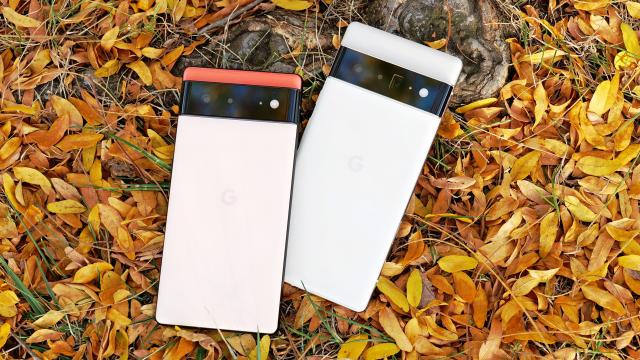Google’s previous Pixels relied too heavily on fancy software to make up for having fewer cameras, smaller batteries, or older processors. But between its custom Tensor chip, updated components, and a slick new design combined with even smarter software, Google has capitalised on the Pixel’s potential at last. And with a starting price of just $999, for people thinking about buying a new phone this year (especially those already familiar with Android), the Pixel 6 is so good you have to seriously ask yourself: Why buy anything else?
Google Pixel 6 and Pixel 6 Pro
What is it?
Google's latest flagship phone
Price
Starts at $999 for the Pixel 6, $1,299 for the Pixel 6 Pro
Like
Awesome pricing, unique design, Tensor chip, tons of high-end features, excellent cameras and new camera modes, smart software, great battery life
Don't Like
$999 base model doesn't support mmWave 5G, no headphone jack, in-screen fingerprint reader could be a bit faster
A Design That’s More Than Just the Camera Bar
Google has never been shy about breaking from tradition when it comes to smartphone design, and with the Pixel 6, the company has done it again. Instead of the boxy camera modules you see on the backs of so many phones, Google has opted for what it calls a Camera Bar, which plays right into the phone’s form and function. On the Pixel 6, Google uses the camera bar as a playful accent to the Pixel 6’s tri-tone design, while also making it so that the Pixel 6 sits flat on a table, which is one of my long-simmering pet peeves about the move toward giant camera modules.
But the biggest change is just how premium the Pixel 6 feels compared to the Pixel 5, with a Gorilla Glass Victus panel in front, Gorilla Glass 6 in back, and an IP 68 rating for dust and water resistance to protect you from life’s dunks and dips. The Pixel 6 and Pixel 6 Pro have their own identities: The standard Pixel 6 has a more down-to-earth matte finish around its edges (which I frankly prefer), while the Pixel 6 Pro gets polished metal sides for a slightly more luxurious look.
Both phones are definitely on the large side. The Pixel 6 features a 2400 x 1080 6.4-inch display with a 90Hz screen and the Pixel 6 Pro a 3120 x 1440 6.7-inch display with a 120Hz screen, which is a potential bummer for people who prefer a smaller device.
Then again, with how great the Pixel 6’s screens look, it’s hard to blame Google for going big. Both phones put out excellent brightness north of 750 nits, with deep rich colours thanks to their AMOLED displays, and the super smooth viewing experience that so many people have come to love from screens with higher refresh rates.
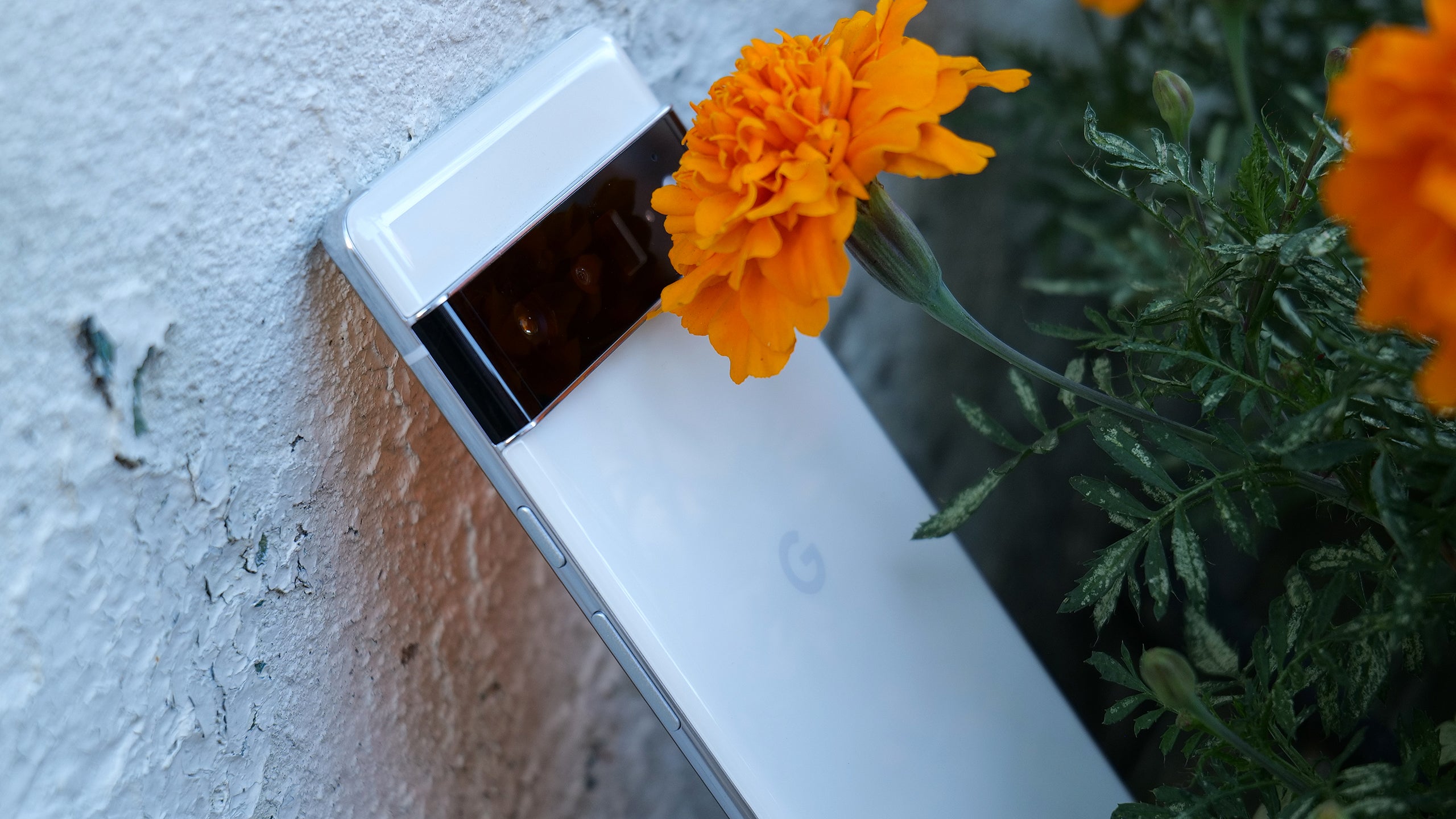
My only quibble with the Pixel 6’s design is that these phones are so big and tall, I wish Google had positioned their power buttons below the volume rocker so it’s easier to reach. I don’t know about you, but I lock and unlock my phone more often than I adjust the volume. I also noticed that depending on the content, the Pixel 6’s stereo speakers can sound a bit hollow, but it’s rather minor.
And while I love the convenience of having an in-screen fingerprint reader (especially when masks are still required in so many places), the speed at which the Pixel 6 recognises my digits feels closer to the first-gen in-screen sensor Samsung used on the Galaxy S10, as opposed to the speedier version Samsung featured in this year’s Galaxy S21. It’s not a huge deal, and once you get used to it, it’s not something you think about during normal use. But it could be faster.
A Different Approach to Flagship Performance
It really can’t be understated how important Google’s Tensor chip is, because not only does it represent Google taking control of chip development for its phones, it also allows the company to ensure the Pixel 6’s performance will deliver the best results. Google says benchmark numbers aren’t everything, and with the Pixel 6, I can see why. On synthetic tests of overall system performance like Geekbench 5, the Pixel posted scores of around 2,700 for multicore performance compared to around 3,600 for phones with Snapdragon 888 chips like the S21. The Pixel 6 seems to lag behind. However, on graphics tests like 3DMark’s Slingshot Extreme Unlimited, the Pixel 6 and 6 Pro’s scores of around 8,600 were basically dead even with the S21 Ultra’s mark of 8,594.
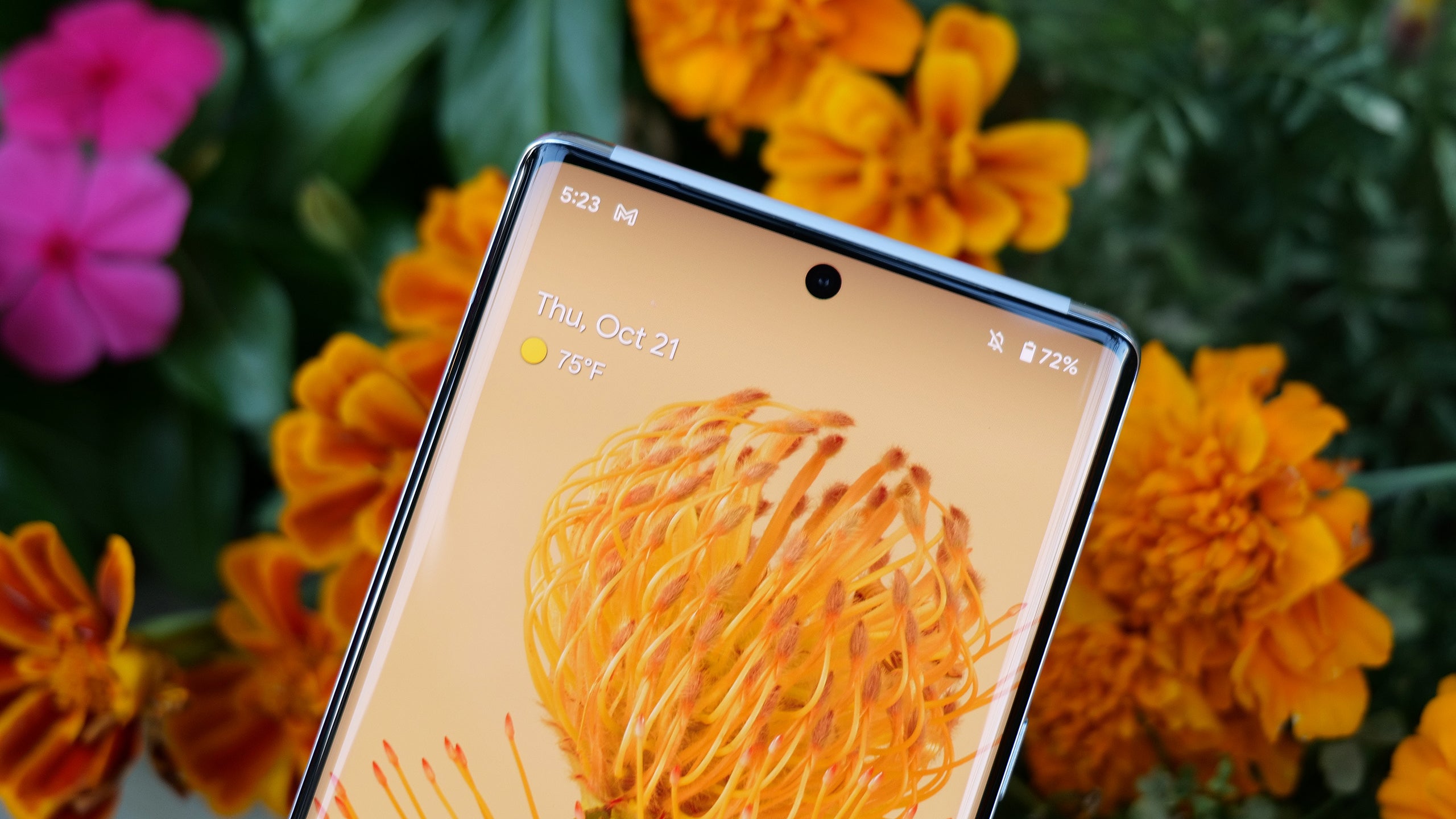
But more importantly, Google’s Tensor chips provide more powerful neural processing, which makes the Pixel 6 faster and more power-efficient when performing AI and machine learning functions. That’s Google’s bread and butter. According to Google hardware chief Rick Osterloh, this makes it possible for the Pixel 6 to do things it simply couldn’t do before using an off-the-shelf mobile chip, especially when it comes to running more accurate voice models on-device. There’s no need to call down for help from the cloud, which increases power efficiency even further (more on that later), and it also ensures there’s less chance Google or anyone might be privy to sensitive information.
Even without the most impressive benchmark numbers, both the Pixel 6 (with 8GB of RAM and 128 of base storage) and Pixel 6 Pro (12GB of RAM and 128GB of base storage) still boot apps and multitask as well as any Android phones on the market (aside from true big-screen behemoths like Samsung’s Galaxy Z Fold 3). The only people who I can think of who might have issues with this kind of performance are hardcore mobile gamers, and for them, there are phones like the Asus ROG Phone 5.
Smart Software Overload
With the introduction of Google’s Tensor chip, it honestly feels like the floodgates have opened when it comes to how Google will leverage that added AI and ML performance. The number of clever new software tricks in the Pixel 6 is actually kind of jaw-dropping. Thanks to Material You in Android 12, making your phone’s entire interface match your wallpaper is as easy a tapping a single toggle. You can turn on Google’s slick minimalist app icons by enabling the Theme Icons settings in the Pixel 6’s wallpaper menu. But that’s just the start. We cover more of this over here!
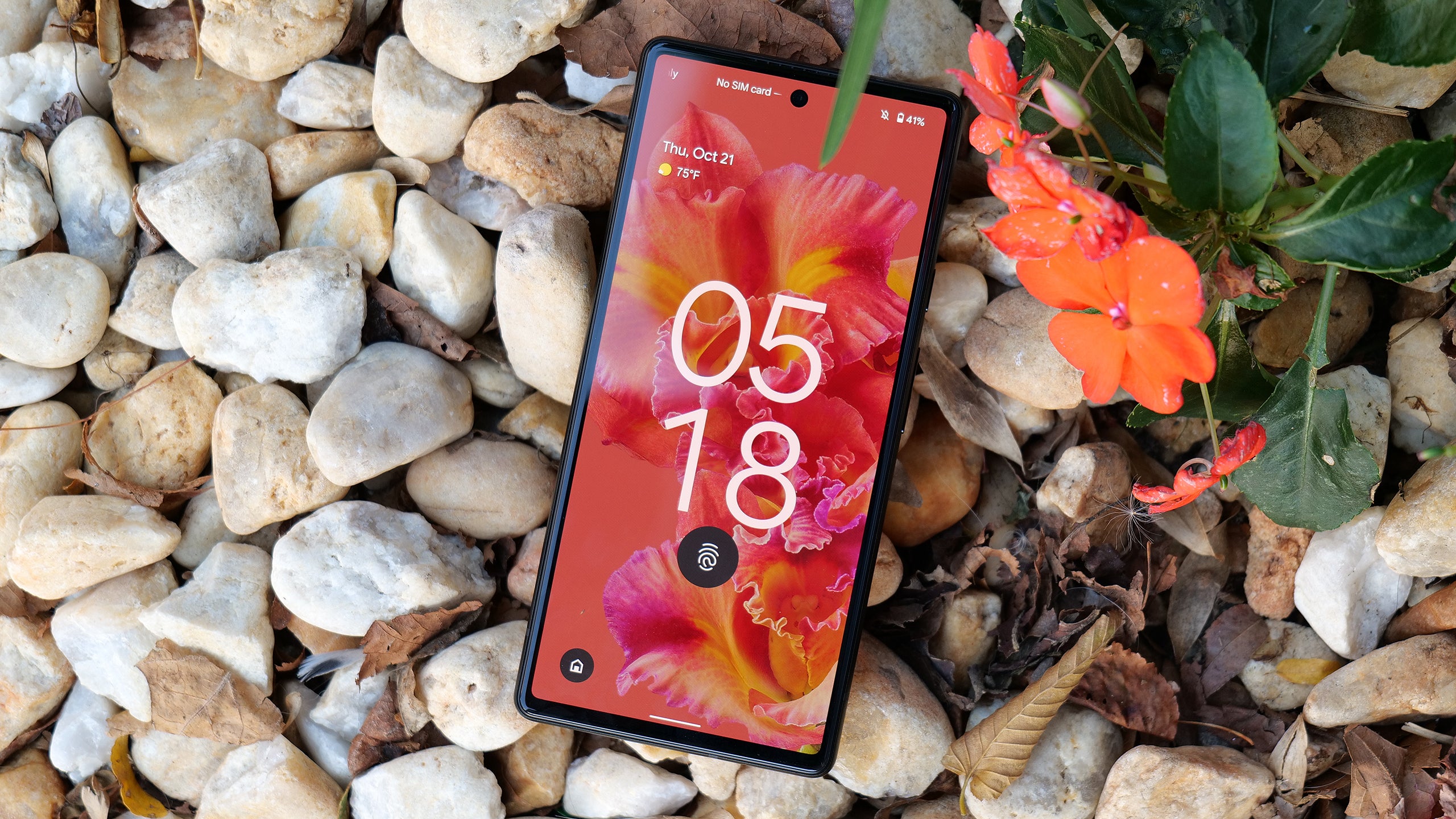
First, there’s Google Calling Assistant, which is useful for folks who hate dealing with automated phone agents when calling a big company’s customer support. There’s also a new Google Assistant-powered Voice Typing feature that you can activate in Gboard by saying “Hey Google, type,” so you can dictate your texts (including emojis) instead of tapping or swiping them out one word at a time. And if the Assistant ever gets it wrong, you can edit your text in real-time by typing, use commands like “Clear” or “Stop” whenever you want, or just say “Send” when you’re done.
The Pixel 6 is also borrowing a trick from Google’s Nest Hubs and smart displays with the ability to answer or decline calls, or stop and snooze alarms just by saying the word — no need to say “Hey, Google” first. With the power of Tensor, Google is able to use higher quality voice models across various apps, which makes my favourite Pixel app, the Recorder App (which now supports German and Japanese), even better. And while the Pixel 6’s speech recognition isn’t perfect, all of these features work as good or even better than you expect, and it’s kind of magical.
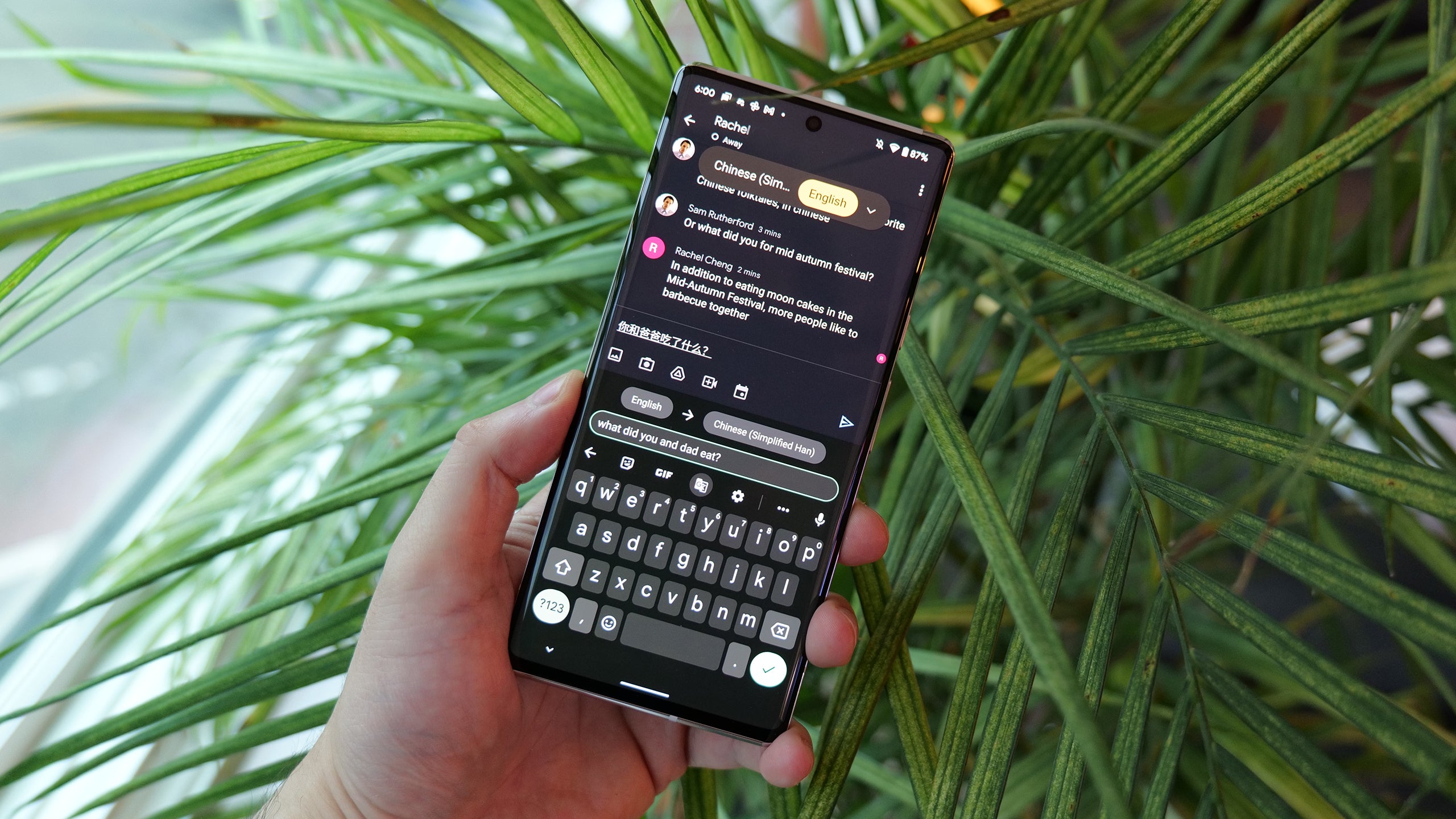
But for me, the feature that really hits home is the Pixel 6’s Live Translate feature, which works in several ways. You can turn on Live Captions to translate audio and video in real-time, or use Interpreter Mode or Google Lens in the camera app to translate to help you get out of a jam while travelling. But my favourite is the new Live Translate feature for messaging, which works across a bunch of messaging apps (Google Chat, Android Messages, Snapchat, Signal, Line, Twitter, FB Messenger, and more) in 11 different languages (English, French, Japanese, Spanish, German, Italian, Portuguese, Simplified Chinese, Hindi, Polish, Russian).
As a half-Asian person with Taiwanese roots on my Mum’s side, I feel like a louse for never becoming fluent in Chinese (I spent a year and a half learning Mandarin overseas in Taiwan, but came back to the U.S. before getting a complete grasp on the language). This has made it challenging to stay in touch with a lot of my extended family over there, but now thanks to some help from a resourceful AI, my language gap suddenly feels a lot less daunting.
Google isn’t truly fluent in Chinese either (it incorrectly translated the character for pomelo to grapefruit), but sometimes a little help is all you need to reinvigorate your efforts. I’m a bit sad that only Simplified Mandarin is supported for now and not Traditional Mandarin, because the latter is the Chinese of choice in Taiwan, and it’s where Google has a number of major offices and thousands of employees.
The Pixel 6 Cameras Are Really That Good
Unsurprisingly, Google is leveraging the power of software and hardware for the Pixel 6’s cameras. Both the Pixel 6 and Pixel 6 Pro come with the same 50-megapixel main cam and 12-MP ultra-wide cam, while the Pixel 6 Pro features a bonus telephoto cam with a 4x optical zoom, making it the first Pixel to ever sport both a telephoto and an ultra-wide lens.
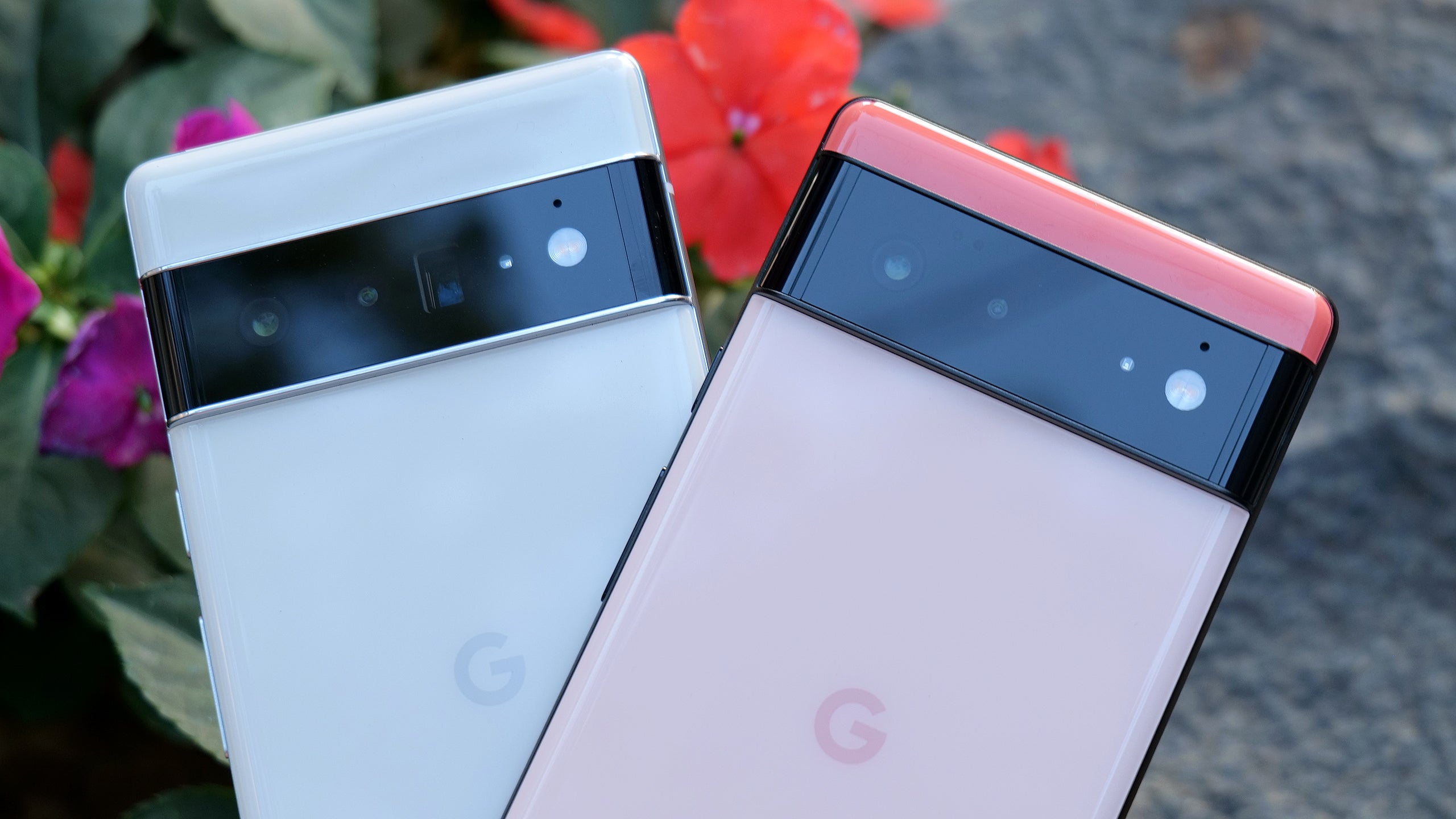
It might seem wild that Google is just now reaching this milestone when phones from Apple and Samsung have had both for years, but it really drives home the point that the Pixel 6 is the beginning of Google’s hardware push. And after waiting all this time to see it happen, the results are worth it.
Everything from photos taken in bright light to low-light Night Sight shots look clear and crisp, with the Pixel 6 routinely capturing more fine details than any of its competition. In a shot of a lonely tree, not only did the Pixel 6 Pro do a better job of capturing the colours and the veins on the tree’s leaves, it captured deeper and more accurate greens on the surrounding grass. Then, in another shot down an alley, the Pixel 6 Pro really impressed with a photo that showed off the phone’s dynamic range while the iPhone 13 Pro’s pic left the leaves and parts of the sky looking almost neon. Even in a shot as mundane as a bed of flowers, the Pixel 6 Pro did a better job of tamping down over-saturation, which continues to be one of the ongoing weaknesses of Samsung’s cameras.
And in low light, it’s not even really a contest, as Google’s Night Sight continues to best all comers when trying to take pics in the dark. I’m really not sure why iPhones still don’t have a dedicated low-light mode, but they definitely need one, as evidenced by a nighttime cityscape where the Pixel 6 Pro captured a sharper, more colourful pic without suffering nearly as much from the presence of unwanted lens flare.
The Pixel 6 Pro’s 4x optical zoom stacked up quite favourably to Samsung’s Galaxy S21 Ultra at 4x, which is just lovely for people like me who constantly long for more reach from smartphone cameras. However, while that reach can be extended up to 20x thanks to Google’s Super Res Zoom tech, compared to the S21 Ultra’s 10x optical zoom, Samsung is still keeping the crown for the best zoom on a phone. The Pixel 6 Pro’s telephoto is good, but Samsung’s is better.
Excellent Battery Life, Convenient Extras
When it comes to battery life, I’m not sure what’s more impressive: the Pixel 6’s daily performance, or its score on our video rundown test. In the real world, both the Pixel 6 and Pixel 6 Pro routinely had 30 per cent to 40 per cent battery left in the tank at the end of the day, and that often included the time I spent testing various features over and over again. No doubt Google’s Tensor chip plays a big part in the Pixel 6’s energy efficiency, which is critical as people start to really take advantage of the phone’s various AI and machine learning-powered features more often.
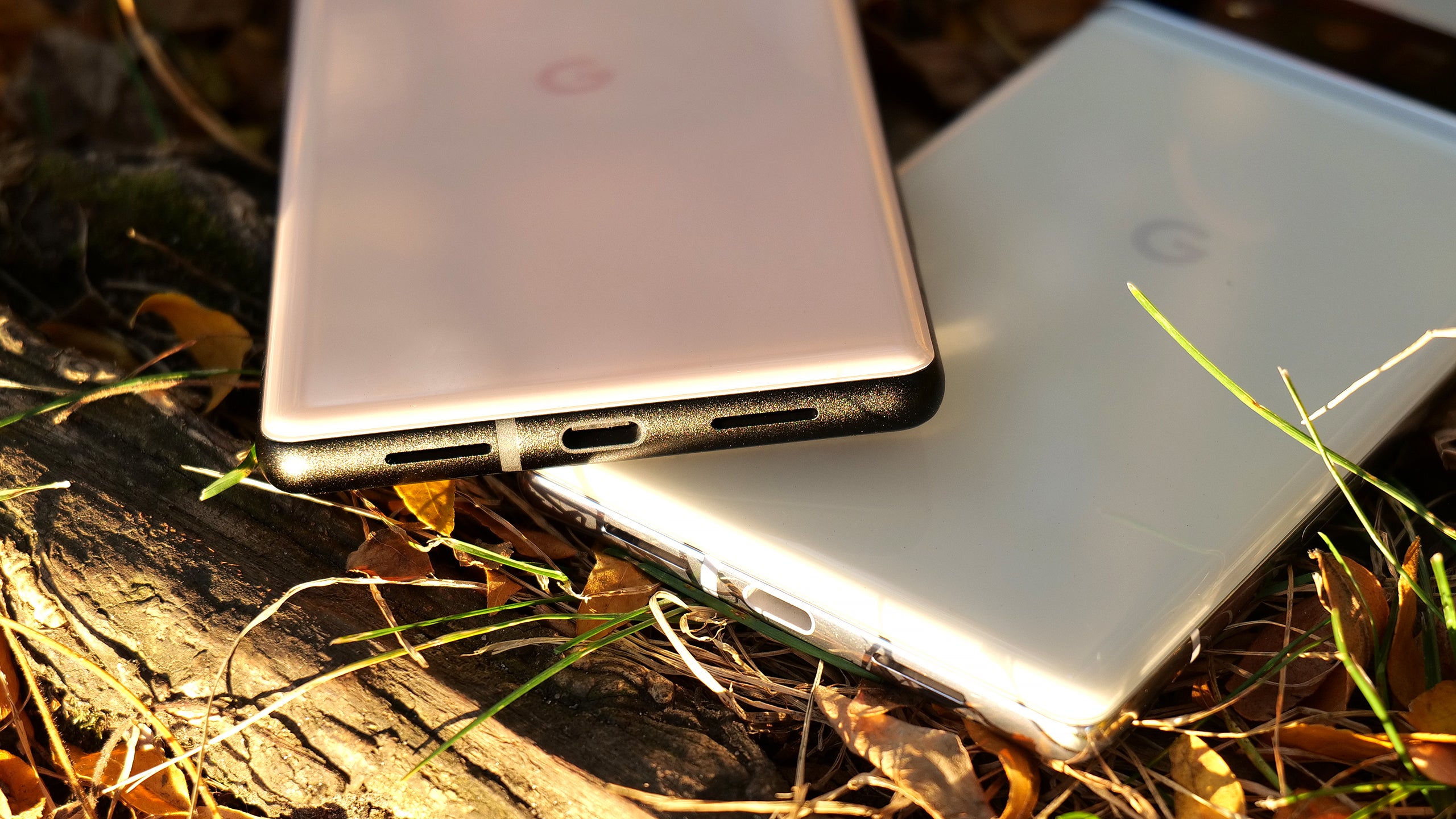
On our battery test, the standard Pixel 6 posted an outstanding time of 18 hours and 56 minutes, which is the second best time we’ve seen from any phone this year, right behind the iPhone 13 Pro Max (19:30). And while the Pixel 6 Pro wasn’t quite as impressive, lasting 16:45, it tied the Galaxy S21 Ultra while handily beating the OnePlus 9 Pro (13:54), and others.
Battery life isn’t the only power upgrade the Pixel 6 got. Google also upped its charging speeds to 30 watts when wired charging (just make sure you have a 30-watt USB-PD 3.0 power adaptor), or up to 21 to 23 watts (depending on the model) when charging wirelessly with Google’s forthcoming second-gen Pixel Stand. And even if you don’t have a first-party Google wireless charger, you still get 12-watt wireless charging, which ain’t bad. If you’re ever out and one of your other devices with wireless charging is running low, the Pixel 6 even has reverse wireless charging, so you can share some of your phone’s excess juice with a device in need.
A Bigger Emphasis on Security
These days, managing your digital security can feel downright overwhelming. But one of the best things about the Pixel 6 is that with its new Titan M2 coprocessor and its new Security Hub, Google makes it easy to shore up any holes — both on your device and online. In the security hub, you’ll get notifications if Google detects that one of your passwords may have been compromised, tips on how you can further improve your security, and even a general score to see how good (or bad) you’re doing.

Google is now even committing to five years of security updates for the Pixel 6 (which is now the longest among all Android phones) plus three years of OS upgrades, so the Pixel 6 should be easy to hold onto for longer without worry or fear of FOMO. And for those not accustomed to dealing with scams and phishing attacks, the Pixel 6 will even warn you if someone sends you a message asking for your password. Pro tip: Don’t ever hand your password over. Any major company worth their salt should have multiple ways of verifying who you are without you needing to send your password in plain text.
The Best Phone for the Money
When I had a chance to get an early look at the Pixel 6 back in August, my big takeaway was that this is the most confidence I’ve seen from Google about any Pixel to date. And after testing out the Pixel 6, it’s not hard to see why. More than any Google device before, the Pixel 6 demonstrates the power and potential of machine learning and ambient computing. There really is much more to performance than big numbers, but to make it happen, you need clever software and sophisticated hardware optimised to make those apps and features shine. The Pixel 6 totally delivers.
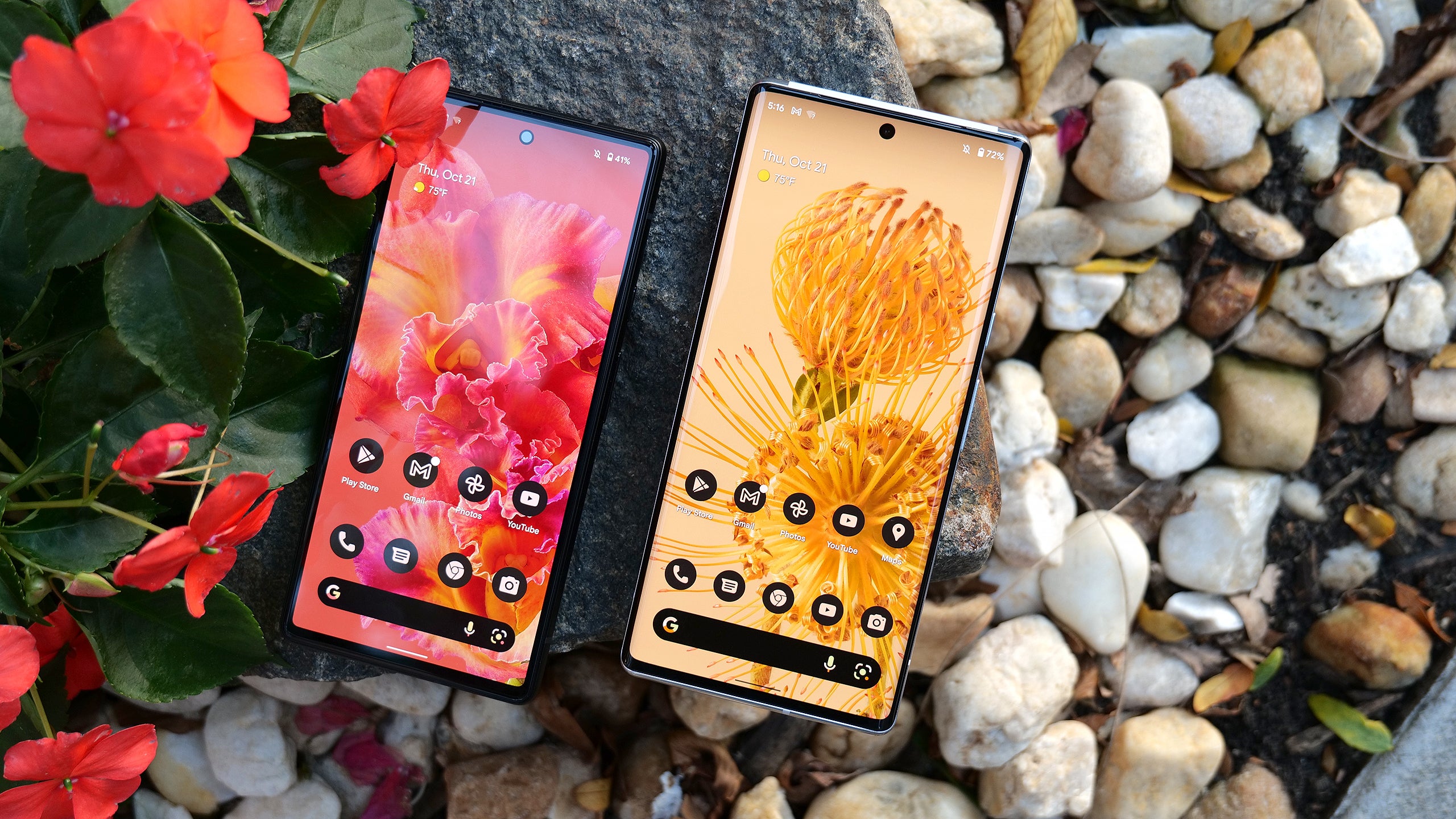
If all you care about is getting the best phone for your money, the Pixel 6 is it. It’s a flagship through and through. Its good looks won’t be confused with any other phone (the cases are rather fetching, too), it offers a new take on smartphone performance, improved security, and the best cameras you can get on a phone today. And once again, the Pixel 6 starts at just $999 less than an iPhone 13 or Galaxy S21. And the Pixel 6 Pro is basically a more affordable S21 Ultra without built-in stylus support and way better software. Honestly, what’s not to like? If you’re looking for the best phone for the money, there’s no reason to buy anything else.
